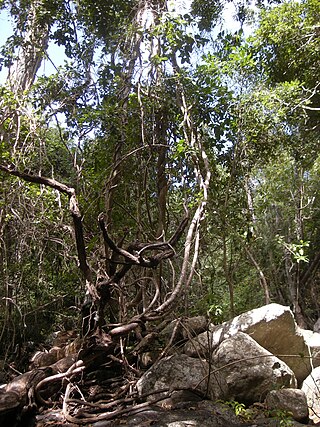
A vine is any plant with a growth habit of trailing or scandent stems, lianas or runners. The word vine can also refer to such stems or runners themselves, for instance, when used in wicker work.

Wisteria is a genus of flowering plants in the legume family, Fabaceae (Leguminosae). The genus includes four species of woody twining vines that are native to China, Japan, Korea, Vietnam, southern Canada, the Eastern United States, and north of Iran. They were later introduced to France, Germany and various other countries in Europe. Some species are popular ornamental plants. The genus name is also used as the English name, and may then be spelt 'wistaria'. In some countries in Western and Central Europe, Wisteria is also known by a variant spelling of the genus in which species were formerly placed, Glycine. Examples include the French glycines, the German Glyzinie, and the Polish glicynia.

A liana is a long-stemmed, woody vine that is rooted in the soil at ground level and uses trees, as well as other means of vertical support, to climb up to the canopy in search of direct sunlight. The word liana does not refer to a taxonomic grouping, but rather a habit of plant growth – much like tree or shrub. It comes from standard French liane, itself from an Antilles French dialect word meaning to sheave.

Hasora khoda, the large banded awl, is a butterfly belonging to the family Hesperiidae which is found in India, parts of Southeast Asia and Australia.

Callerya is a genus of flowering plants in the legume family, Fabaceae. It belongs to the subfamily Faboideae, tribe Wisterieae. Its species are climbers, generally reaching up to about 1 m (3 ft) tall. The genus has a somewhat complicated taxonomic history; its circumscription was substantially revised in 2019.
Endosamara is a monotypic genus of flowering plants in the legume family Fabaceae, tribe Wisterieae. Its only species is Endosamara racemosa, a liana found from South India through Indo-China to the Philippines.
S. chinensis may refer to:
S. grandiflora may refer to:

Candalides absimilis, the pencilled blue or common pencil-blue, is a species of butterfly of the family Lycaenidae. It is found along the east coast of Australia, including Queensland, the Australian Capital Territory, New South Wales and Victoria.

Austrocallerya megasperma, one of several species commonly known as native wisteria, is a species of flowering plant in the family Fabaceae and is endemic to eastern Australia. It is a woody climber with pinnate leaves and racemes of purple, pea-like flowers.

Hardenbergia comptoniana is a species of flowering plant in the pea family, Fabaceae, native to Western Australia. It is known as native wisteria, a name also used for Austrocallerya megasperma. A twining vine, it produces purple flowers in the Southern Hemisphere spring. It is found on sand dunes and sand plains, and in open forest, on sand- or clay-based soils. It is readily cultivated in the garden, where it does best in a part-shaded position.
Padbruggea is a genus of flowering plants in the family Fabaceae. Its native range stretches from southern China to western Malesia.

Wisteriopsis is a genus of flowering plants belonging to the family Fabaceae. Its native range is China to Indo-China and Temperate Eastern Asia. Wisteriopsis species are twining woody vines, generally resembling species of Wisteria. The genus was established in 2019 as a result of a molecular phylogenetic study, and includes species formerly placed in Millettia or Callerya.

Austrocallerya is a genus of flowering plants belonging to the subfamily Faboideae in the family Fabaceae. They are robust, twining woody vines.

Anne M. Schot is a Nederlander botanist.

Wisterieae is a tribe of flowering plants in the bean family Fabaceae. The tribe was first described in 1994 for the sole genus Wisteria, but was greatly expanded in 2019 to include 13 genera, six of which were new. Five had previously been placed in the tribe Millettieae. Members of the tribe are climbers of various kinds. Some, like Wisteria, are cultivated for their flowers.
Kanburia is a genus of flowering plant in the family Fabaceae, native to Thailand. The genus was established in 2019. Kanburia species are twining woody vines.

Austrocallerya pilipes, synonym Callerya pilipes, is a species of flowering plant in the family Fabaceae, endemic to Queensland, Australia. It is a robust twining vine, climbing up trees and shrubs. It is known as the northern wistaria.

Austrocallerya australis, commonly known as native wisteria, blunt wisteria or Samson's sinew in Australia, is a species of flowering plant in the family Fabaceae, native to north-eastern Australia, New Guinea and some Pacific Islands. It is a tall, woody climber with pinnate leaves, the leaflets oblong, elliptic or egg-shaped, and panicles of purple, pea-like flowers.











